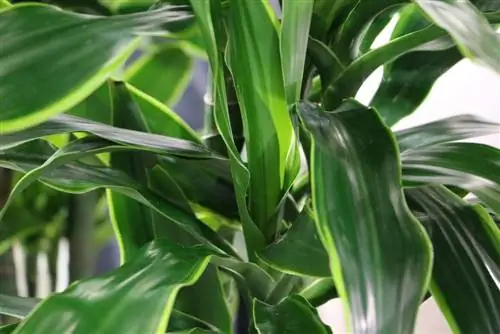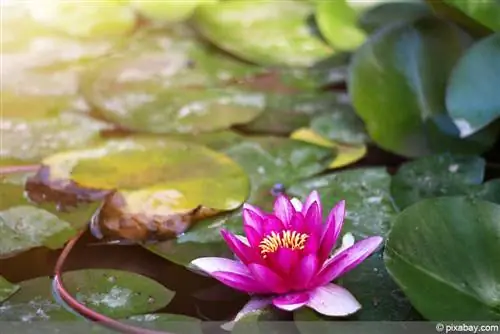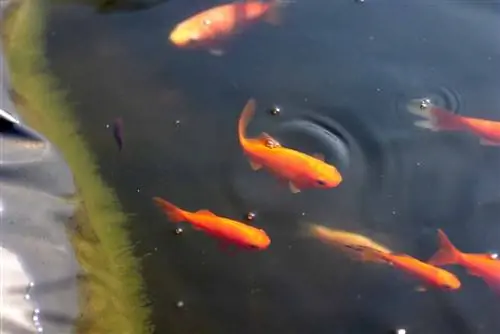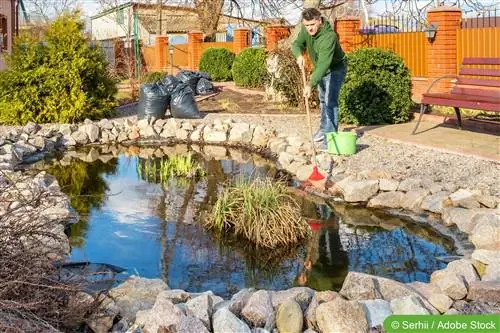- Author admin [email protected].
- Public 2023-12-17 03:39.
- Last modified 2025-06-01 06:48.
Underwater plants are the most important plants in the pond because they ensure that the biological balance in the pond is maintained. However, you should only save the underwater plants that fit in well at the location and do not require additional work themselves from manual “pond cleaning”. That's why we're introducing the native underwater plants that naturally fit best into the pond (in both senses) and are the easiest to care for:
The native species of underwater plants
Underwater plants are urgently needed in every pond: They process all the unnecessary nutrients that collect in the water and on the ground over time, eating away so much of the algae in the pond that they cannot multiply excessively (and then turn the pond water into a “cloudy soup”) and supply the organisms living in the pond (including the microorganisms that live in ponds without fish) with oxygen, right down to the bottom of the bottom - if none of this happens, it will sooner or later the biological balance in the pond will say goodbye.
There are many underwater plants that perform all of these tasks; But the native underwater plants are also easy to care for, grow easily and don't cause any trouble in winter (anyone who has had to collect dead plants from the bottom of the pond will definitely want to avoid this experience in the future). Strong arguments for a number of widespread, but also rare and endangered native plants, which cannot be helped by the fact that they are not as well-known as dandelions and daisies and are therefore now presented:
A to N
Milfoil,Myriophyllum spicatum
- Growth height 30 - 100 cm length
- Water depth: 20 - 150 cm
- robust, vigorous plants
- adaptable cleaning plant
- can regulate algae growth alone as a larger population
Thick-leaved waterweed,Egeria densa
- Growth height up to 1 m in length
- Water depth 20 - 150 cm
- very good oxygen dispenser
Originally native to Brazil and Argentina, but now naturalized worldwide and so far unproblematic, at least in Europe, releases oxygen into the pond water even under a layer of ice, an attractive he alth police for the pond.
Flower pondweed,Potamogeton perfoliatus
- Growth height up to 2.5 m long
- Water depth: 50 - 250 cm
- fast-growing
- can grow up to 6 m long in optimal natural locations and can simply be cut back
- But it's still not for mini ponds
Frogweed,Luronium natans
- Growth height up to 5 cm
- Water depth: 10 - 40 cm
- local rarity
- is protected
- preferably nutrient-poor water
- prefers soft water
Shiny or Mirror Pondweed,Potamogeton lucens
- Growing rapidly
- but roots under water
- perennial and very decorative oxygen plant
- which stretches its flower heads over the surface of the water for wind pollination
Smooth Hornwort,Ceratophyllum submersum
- Growth length up to 80 cm
- Water depth: 20 - 100 cm
- suitable for standing water
- can regulate algae growth alone as a larger population
Crab claw, water aloe,Stratiotes aloides
- Floating plant under nature protection
- which grows freely in deeper water
- roots in the ground in shallow water
Great plant for ponds that are not too small with clean water that is low in lime; With whose settlement you will help save the endangered green mosaic damsel, a rare species of dragonfly that only lays its eggs on crab claws.
Needles,Eleocharis acicularis
- Growth height 5 - 15 cm
- Water depth: 0 - 50 cm
- vigorous and adaptable
- can regulate algae growth alone as a larger population
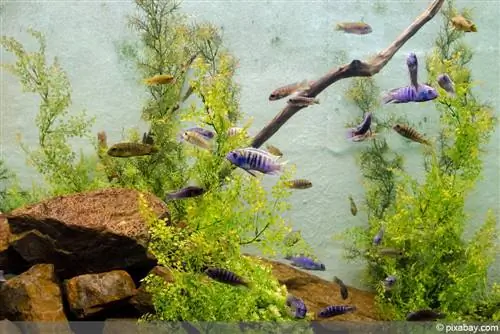
Q to W
Spring moss,Fontinalis antipyretica
- Growth height up to 30 cm in length
- Water depth: 10 - 300 cm
- demanding plant
- who like to be in light currents
- preferably clean
- does not grow in nutrient-rich pond water
- Widespread and willing to grow
- Underwater carpet-forming oxygen supplier
- that gets excessive algae growth under control
Whorled Milfoil,Myriophyllum verticillatum
- Growth height up to 2 m underwater
- Water depth: 40 - 200 cm
- likes softer water
- can regulate algae growth alone as a larger population
Rough Hornwort,Ceratophyllum demersum
- Growth length up to 2 m
- Water depth: 20 - 200 cm
- a cleaning devil for every pond
- which, as a larger population, regulates the growth of algae on its own
Seapot,Nymphoides peltata
- Deep-water plant rooted to the bottom
- Water depths of 20 - 60 cm
- up to 150 cm length
- Flooding stems with almost round, dark green leaves
- small yellow flowers floating on the surface of the water
Rare native pond plant under nature protection, for sunny, warm, nutrient-rich ponds, which sometimes grows a little hesitantly, but can then become very vigorous and spreading - the popular ornamental plant is therefore unfortunately not for small garden ponds.
Floating pondweed,Potamogeton natans
- Length up to 1.2 m
- Water depth: 20 - 120 cm
- deep-rooted floating plant
Smallest native pondweed, but even this is best planted in a basket in small garden ponds.
Water feather,Hottonia palustris
- Floating plant rooted in the depths
- which grows from water depths of 10 to 40 cm to the surface
- but needs a place where it is not pressured by strong competition
- is protected
Water crowfoot,Ranunculus aquatilis
- Growth height up to 5 cm above the water surface
- Water depths of 20 - 100 cm
- Fine-leaved, vigorous, valuable water purification plant
- for slightly larger garden ponds
- which doesn't always grow reliably
- feels particularly comfortable in clean, low-calcium water
Water Star,Callitriche palustris
- Roots at the bottom
- grows in water depths up to 50 cm to the surface
- suitable for natural ponds
- which supplies them with oxygen even under a blanket of ice
Tip:
Underwater plants have important tasks in the pond, most of which they carry out and are intended to carry out underwater; However, they are not completely irrelevant to the design of the pond. Because the “colors under water” also work - it makes quite a difference whether the ground is overgrown with dense, very light green threads of a thick-leaved waterweed or whether the delicate, upright shoots of a mixed pondweed with large, elongated leaves shimmer through to the surface.
Shopping and special care needs
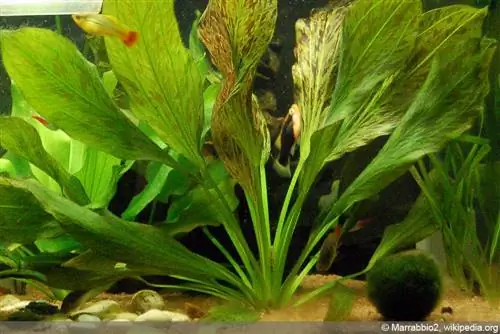
There are several species or varieties of many of these native pond plants, especially in very small ponds, the height and speed of growth are very important, so each of these should be researched before purchasing. If the respective species/variety could become too large for the pond, you should only try this plant if it can be placed in a plant basket and can be easily moved or removed from the pond.
If one of these plants behaves a bit strangely toward winter, it's not necessarily cause for concern unless you accidentally purchased an Asian import or a tropical variety of native pond plant. But simple information about the growth processes usually helps:
The water plague e.g. B. usually forms winter buds in autumn, from which they sprout again in spring; In mild winters, the entire plant sometimes hibernates. Some of the free-floating plants, such as the crab claws, sink to the bottom in autumn and also form winter buds; they reappear of their own accord in spring. Because of these winter buds, you should no longer move pond plants from August onwards; they are now in the middle of producing winter buds and would no longer take root.
If submerged species have built up dense cushions in late summer, the stocks growing freely in the water should be thinned out in order to extract “a good boost” of biomass and nutrients from the “pond system” before winter.
The pond quickly becomes a nature conservation biotope
If the underwater plants thrive and you then equip the bank area with native swamp and bank plants, you will slowly become the savior of humanity - which, however, is also necessary less slowly because our insect populations have declined in recent decades have fallen dramatically. The plants at the edge of the pond delight aquatic and land insects with their leaves and flowers; and there are also some plants here that need to be saved because they have become so rare that they are protected.
If you don't buy just any bank vegetation, but e.g. B. for broad-leaved cotton grass (Eriophorum latifolium), creeping celery (Helosciadium repens), pill fern (Pilularia globulifera), yellow loosestrife (Lysimachia thyrsifolia), marsh gladiolus (Gladiolus palustris), devil's bite (Succisa pratensis), meadow iris (Iris sibirica) and or If you are looking for dwarf cattails (Typha minima), you are killing several birds with one stone when it comes to nature conservation.
Tip:
The biological balance, which the underwater plants in the pond and the plants around the pond help to maintain, is also important in ponds in which a single fish should never swim. If the pond owner doesn't use any animals himself, that doesn't make a pond (which, in contrast to the "water-filled design object" is intended to bring an image of a natural body of water into the garden) much less "living" - long before every fish there are innumerable ones who worry about it Amounts of microorganisms determine the living conditions in the pond. In addition, the aquatic plants regularly save the lives of larger animals even in ponds without fish: insect larvae, tadpoles, newts and other creatures that have settled on their own urgently need the dense plant population in and around the pond because otherwise they cannot hide from predators.


